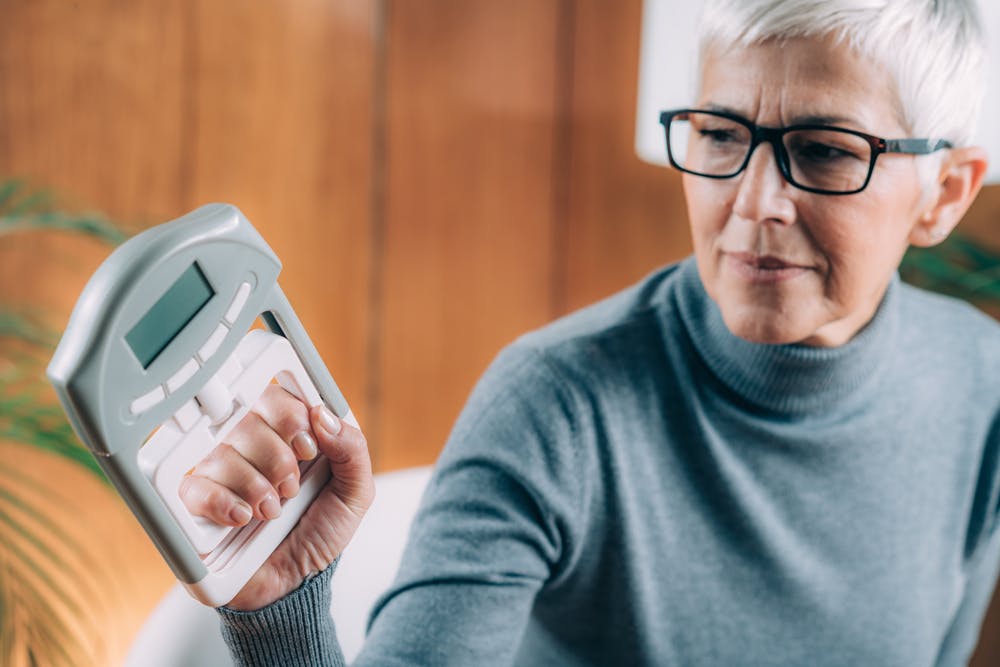Grip Strength and Your Health: What It Reveals About Longevity, Muscle Loss, and Disease Risk
By Dr. Priyali Singh, MD
Reviewed by Kenya Bass, PA-C
Published May 23, 2025
9 min read

Have you ever thought about what your handshake says about you? It might be more than just a social cue. It could actually give clues about your health. Grip strength, a simple measure of how firmly you can squeeze something, has become a surprising tool in the world of health science. It’s not just about showing off at the gym or having a strong handshake at a job interview. Researchers now believe that how strong your grip is may tell you something important about your overall health, your risk for certain diseases, and even how long you might live.
That may sound far-fetched, but the science is compelling. In this article, we'll break down what grip strength really measures, why it matters so much, how it's connected to aging, mental health, and disease risk, and what you can do to improve it.
What Is Grip Strength—and How Is It Measured?
Grip strength is exactly what it sounds like: the strength of the muscles in your hand and forearm. But it's not just a measure of those specific muscles. It's also a quick and easy way to get a general idea of your body’s muscular and functional health.
Doctors and researchers often measure grip strength using a tool called a hand dynamometer. It looks a bit like a fancy clamp with a handle. You squeeze the handle as hard as you can, and it records the force of your grip in kilograms or pounds. The test is painless and only takes a few seconds, but it can reveal a lot.
So, what’s considered a good score? That depends on your age and sex. In general, younger people and men tend to have stronger grips, but what's most important is how your grip strength compares to others in your age group.
Why Grip Strength Matters: The Science-Backed Links
Now you might be wondering, "Okay, but why does this even matter?" The answer lies in decades of research linking grip strength to many aspects of health.
Studies show that people with stronger grip strength tend to live longer. In fact, grip strength is sometimes a better predictor of longevity than blood pressure. That's because it's not just about your hands — it reflects your overall muscle strength and function.
Beyond that, low grip strength has been linked to higher risk of:
- Heart disease
- Stroke
- Type 2 diabetes
- Some types of cancer
It can also predict hospitalizations and recovery times. People with weak grip strength are more likely to have complications after surgery or during illness. All of this means that grip strength could be a simple, non-invasive way to spot health problems before they become serious.
Grip Strength and Aging: A Window Into Muscle and Frailty

As we get older, our muscles naturally start to shrink and weaken. This process, called sarcopenia, usually begins around age 30 and speeds up after age 60. While it's a normal part of aging, it's also a major risk factor for falls, broken bones, and loss of independence.
Grip strength is often the first muscle strength to decline, which makes it an early warning sign of frailty. If someone’s grip strength is below average for their age, it could mean they’re already starting to lose muscle more quickly than normal.
Doctors and researchers use grip strength to help detect frailty in older adults. It’s also a helpful tool for caregivers to understand how much support a person might need with everyday tasks like opening jars, carrying groceries, or using a walker.
But here's the good news: even small improvements in grip strength can lead to big improvements in overall strength and mobility.
Mental Health and Grip Strength: What the Research Says
Believe it or not, your grip strength might also say something about your brain.
A growing body of research shows that weaker grip strength is linked to a higher risk of depression, anxiety, and even cognitive decline. In older adults, low grip strength has been associated with an increased risk of developing Alzheimer’s disease and other forms of dementia.
One theory is that muscle strength and brain health are closely connected through shared pathways, like inflammation and blood flow. Another idea is that people who maintain muscle strength tend to be more active, and regular physical activity is known to support brain health.
Whatever the reason, there’s a clear link: the stronger your grip, the better your chances of staying mentally sharp.
What’s a “Good” Grip Strength Score?
What counts as a strong grip depends on who you are. Here are some general benchmarks based on age and sex:
- Men (ages 20-30): 100 to 120 pounds of force
- Women (ages 20-30): 60 to 80 pounds of force
- Men (ages 60+): 60 to 80 pounds of force
- Women (ages 60+): 40 to 60 pounds of force
Keep in mind that these numbers are averages. What matters most is whether your grip strength is improving, staying steady, or declining over time. If you're seeing a drop, it might be time to take action.
RELATED READ: Fisetin for Anti-Aging and Longevity: Benefits, Science, and How to Use It Safely
How to Improve Grip Strength (and Why It Helps Overall Health)
The great news is that improving your grip strength is fairly easy. And when you strengthen your grip, you’re also likely strengthening other parts of your body, especially your arms, shoulders, and core.
Some simple ways to build grip strength include:
- Carrying heavy objects (like grocery bags or dumbbells)
- Dead hangs from a bar (just hang and hold your body weight)
- Squeezing a tennis ball or grip trainer
- Doing pull-ups or rows
These activities don't just help your hands. They improve your posture, stability, and coordination. They can also boost your confidence in daily activities, from opening stubborn jars to lifting suitcases.
Even better, research shows that increasing grip strength can lower blood pressure, reduce the risk of falls, and support healthier aging overall. It might even help you recover faster after illness or surgery.
When to Test It—and How Often

So, when should you check your grip strength? For most people, once a year is a good start. It’s a helpful number to know, like your blood pressure or cholesterol.
If you’re over 50, have a chronic health condition, or notice that everyday tasks are getting harder, you might want to check it more often.
You can even buy a hand dynamometer online and track your progress at home. Or, ask your doctor to include a grip strength test in your next physical. It’s quick, safe, and surprisingly informative.
Final Thoughts: Small Measure, Big Meaning
It’s easy to overlook something as simple as your grip. But science is showing that it’s a powerful signal of your health, both now and in the future. Whether you’re young and active or older and trying to stay independent, paying attention to your grip strength could give you an edge.
It’s not about having a crushing handshake. It’s about what your muscles say about your heart, your brain, and your ability to age well. And best of all, it’s something you can improve.
So the next time someone asks you for a handshake, give them a strong one, not just for first impressions, but because it might be a sign you’re living a longer, healthier life.
Frequently Asked Questions
1. Can grip strength really predict how long you’ll live?
Yes, studies have shown that grip strength is a strong predictor of longevity. In fact, it can sometimes be more accurate than blood pressure in estimating future health risks and mortality. This is because grip strength reflects overall muscle health, which is closely tied to your body’s ability to recover from illness, resist chronic disease, and maintain independence as you age.
2. Is weak grip strength a sign of heart disease?
It can be. Research has found that people with weaker grip strength are more likely to develop cardiovascular diseases, including heart attacks and strokes. Low grip strength may also be associated with higher levels of inflammation, poor circulation, and reduced physical fitness, all of which contribute to heart problems.
3. Can improving grip strength lower my risk of chronic illness?
Absolutely. Building grip strength usually involves exercises that also strengthen your whole body. Regular strength training improves insulin sensitivity, lowers blood pressure, and reduces inflammation—all of which lower your risk for conditions like type 2 diabetes, hypertension, and arthritis.
4. How do I test grip strength at home without special equipment?
While a hand dynamometer is the most accurate way, you can get a rough idea of your grip strength by doing exercises like holding a heavy grocery bag for time, hanging from a pull-up bar, or timing how long you can hold a squeeze on a tennis ball. Tracking your progress over time can help you notice improvements.
5. Is grip strength important for women too, or just men?
It’s important for everyone. While men generally have higher grip strength, women with strong grip strength have better mobility, lower risk of falls, and improved cognitive health. It’s also a key marker of physical independence later in life.
6. Can children or teenagers benefit from grip strength training?
Yes, but in age-appropriate ways. For kids and teens, developing grip strength helps with sports performance, injury prevention, and long-term muscle development. Activities like climbing, monkey bars, or light resistance training are safe and effective when supervised.
7. What’s the difference between grip strength and hand strength?
They’re closely related but slightly different. Grip strength usually refers to your ability to squeeze or hold something using your whole hand and forearm. Hand strength can also include finger strength or pinch strength. Grip strength is the one more commonly studied in relation to overall health.
8. Can grip strength be improved at any age?
Yes! Whether you’re 20 or 80, it’s never too late to improve your grip strength. Older adults, in particular, can benefit greatly from resistance training focused on the hands, arms, and upper body. Improvements can lead to better balance, fewer falls, and improved daily functioning.
Share this article

What Is Premature Aging and What Can You Do to Prevent or Reverse It?
Dr. Priyali Singh, MD
Sep 28, 202510 min read

Low Sodium Diet: Simple Guidelines, Food Lists, and Tips for Better Health
Lilian E.
Sep 30, 202512 min read

Tips for Staying Healthy: 12 Simple Habits for Energy, Longevity, and Better Living
Editorial Team
Sep 30, 202510 min read

Best-in-class care is a click away
Find everything and everyone you need to reach your metabolic health goals, in one place. It all makes sense with Meto.
Join Meto